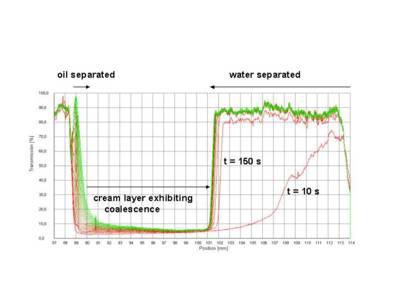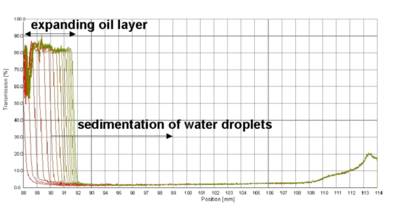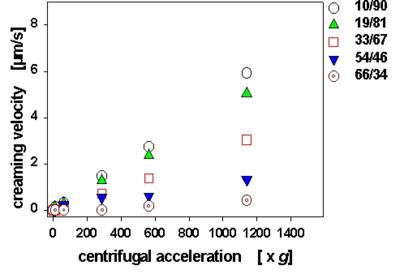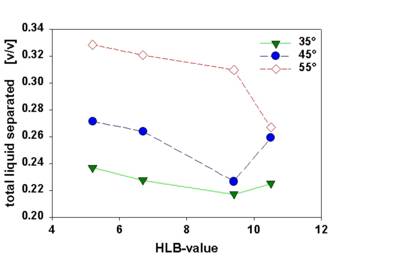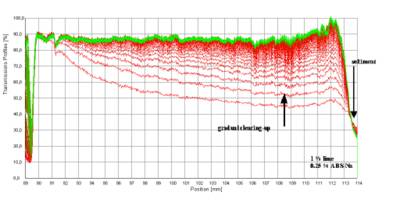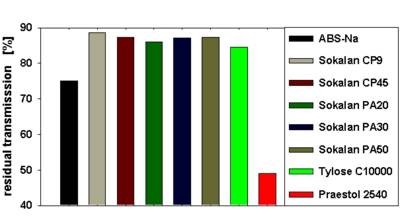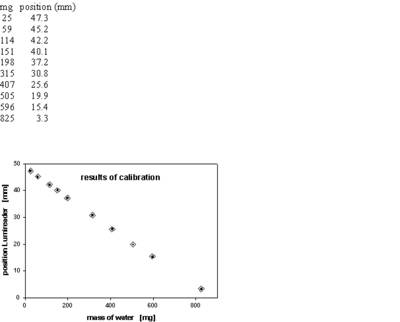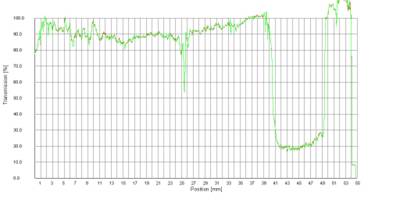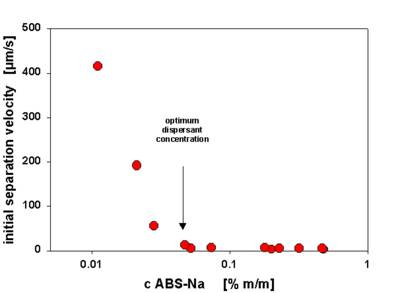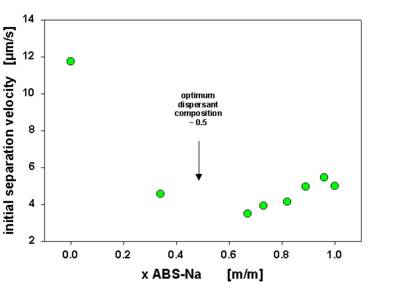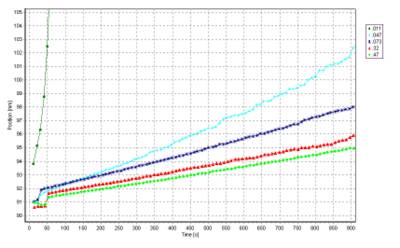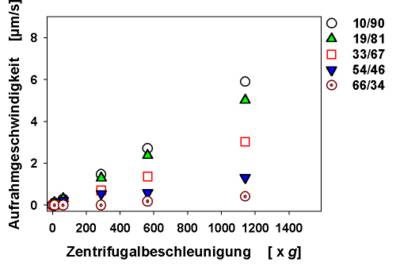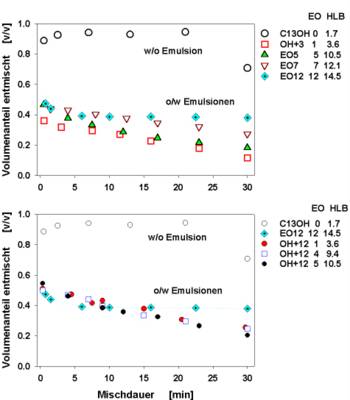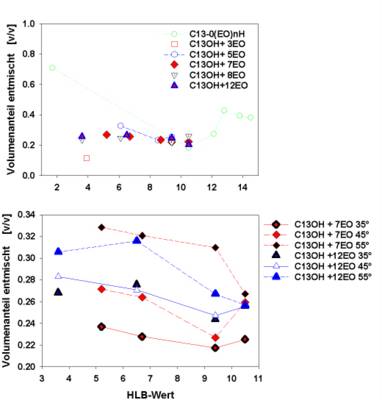Water and Wastewater.com Help Forum - Rising pH in Final Treated Effluent Dilemma
original question by Sewer Doc
Baffled as to why the final pH in grab samples from our final treated tertiary plant effluent clear well have started increasing by approx. 2.5 pH units (from 7.0 to 9.5) within 60 min. of sample collection. (Previously the pH in clear well grab samples was quite stable). We employ breakpoint chlorination, followed by neutralization with KOH and dechlorination with SBS, followed by sand filtration and 4 hours of vigourous aeration (with clean air). The temperature is presently <14c.>First attempt to answer
indeed very strange. As biological causes can be rouled out chemical reasons are left. That is, surely the KOH is overdosed. The most likely reason is that the quality of your KOH feed has changed.
Normally by standing a KOH solution will take up carbon dioxide and the KOH solution becomes saturated regarding kalium carbonate. The finaly dispersed particles eventually will get into solution only in your final effluent.
Dosing a diluted KOH feed or simply a reduction of the KOH amount may solve the problem.
reply by Sewer Doc
I agree it is a chemical reaction. I ran some experiments today - Whereas the pH increased within 1 hour for samples from the clear well, further upstream (after the sand filter and in one of the aeration tanks), a similar increase occurred but only a lag of about 5 hours and 3 hours, respectively. In the case of the sand filter sample, it did not go through our 3-4 hour aeration step, showing that oxidation of something by air was not responsible for what was happening.
With respect to KOH, we receive 2-3 deliveries of liquid KOH per week - same supplier past 3 years. KOH addition to the dechlor tank is controlled automatically by a on-line sensor which is calibrated regularly and checked against a calibrated lab pH meter. This is carefully controlled to ensure that the water at the point and time of discharge meets our pH limit.
second attempt
treating the system as a black box obviously the KOH feed has to be reduced somewhat to ensure that the discharge is meeting the limit.
To continue the speculation
If indeed the KOH feed contains particulate carbonate this would explain why the on-line sensor allows for overdosing (it does not 'see' the alkalinity provided by the particulate carbonate).
Further, if there is a deviation from ideal mixing this will also lead to overdosing.
Why the shift in pH requires longer times upstream
An alternative explanation to the 'particulate' hypothesis is an oversaturation with carbon dioxide, which leads to formation of a kalium hydrocarbonate solution, which is neutral. I do not know if it is possible that this solution releases carbon dioxide to the air under ambient conditions. This would lead to the formation of a kalium carbonate solution, which is alkaline. This would mean that the oversaturation upstream is stronger.
You might check the hypotesis with a dilute KOH solution.
reply by Grrun
Since you have checked the pH sensor for reliability, then I suggest that you check the KOH pump controls. Another possibility is (if you have one in the system) the back pressure valve for positive displacement pumps; it could possibly fail in the open position or a diaphram could have ruptured. If you don't have a backpressure valve, then KOH could possibly flow through a metering pump if the discharge is lower than the KOH tank.
reply by judo
Just out of curiosity, does the pH of your effluent keep not increasing during "4 hours of vigorous aeration", and suddenly start increasing right after the "grabbing" ?
What would happen if you make the "vigorous aeration time" a bit longer, like another 60 minutes?
reply by Sewer Doc
Thanks for all of the comments and suggestions. We have not tested the particulate suggestion. It is simple enough so we will do so.
All on-line instrumentation & controllers in the plant were professionally calibrated in late Sept. and several have been rechecked since then.
We use Prominent pumps which are 1-2 years old and which appear to be operating well. We run daily drawdown checks.
Regarding aeration, we have observed that aeration holds the pH in check. After ceasing aeration, pH increases. In samples held on the bench and allowed to increase their pH, subsequent aeration reduces pH. Addition of a small amount of Sodium bisulfite to a fresh sample drops pH by about 1 unit and holds it there. If aeration is then turned on, it drives the SBS off and the pH rises to the equivalent pH for aeration alone.
Over the past 6 months, the ammonia concentration in the raw water feed to the tertiary plant has increased significantly. To treat the increased ammonia in the breakpoint chlorination reactors (which were sized to provide sufficient reaction time to treat a much lower ammonia conc.) the hypo dose had to be doubled, to achieve >99.5% ammonia reduction.
As a result, we now find that the residual chlorine concentration in the dechlorination tank is now much higher, requiring double the SBS dose as last year to dechlorinate, and 4x the KOH for adjustment to our target pH. Given the complexity of the water and the high levels of these process chemicals, it probably should not be a surprise that some subtle lingering chemical reaction(s) are occurring in our final treated water which affect its pH over time.
As a trial, we significantly reduced the raw water flow into the tertiary plant yesterday to provide a longer residence time in the chlorination tanks and provide a longer time for aeration in the aeration tanks, to hopefully eliminate these problems.
Reply by Grrun
Usually, acid-base reactions are quite rapid and I don't have a good explanation for the reactions taking place. However, if you are using 4X the KOH that you used previously and your water has a 9.5 pH; it seems to me that you are feeding a strong alkali that is the only likely candidate to cause the pH to rise that high. You may want to change your pH aim to compensate for some change in your influent chemical composition (perhaps even running pH titration curves with KOH and allowing time for any delayed reaction to occur).
Anyway, I hope you'll share the solution to this puzzel with the Forum when you solve it!
Reply by Sewer Doc
I can't really play around with my pH. At the discharge point it must be between 6.5 - 8.5. We strive to control it at about 6.6, but this is not that easy since the effluent buffers poorly in this pH zone. The pH change happens thereafter, where it impacts the testing of samples sent to off-site labs for other compliance tests.
Filtering the effluent as was suggested by another respondent did not help. Nor did cutting the raw water flow into the plant down to 100 usgm (from 240 usgm a few weeks ago). In all cases the pH rose quickly as the samples "aged"
Re: the point about stoichiomentry, I believe the overal reaction for break point chlorination is: 3NaOCl + 2NH3 --> N2 + 3NaCl + 3H2O I am sure that we are adding much more NaOCl than this as a lot of the chlorine is lost to atmosphere from the tanks. We try to minimize NaOCl dose by targeting the ammonia conc. in the treated effluent from the chlorination tanks to be between 0.5 - 1.5 mg/L.
We have now sought the assistance of a good inorganic chemist I know. If we find the cause of the problem, I will be happy to post an update.
This problem, while scientificallly interesting, is something I really wish would go away.
next answer
as mentioned earlier to high pH in the effluent means the input of alkalinity is too high, even if your on-line pH reading says it is okay.
So why not reducing the amount of KOH added?
After all the slow shift in pH seems to be indeed associated with the degree of carbon dioxide over-saturation, i.e. with a shift from hydrogencarbonate (neutral) to carbonate (alkaline).
Reply by Sewer Doc
At the point and time the discharged effluent leaves my plant, it must be between pH 6.5 to 8.5 otherwise I am not compliant. We successfully maintain the the pH at 6.6, as measured by an on-line pH meter. In the past, we never had this problem - th pH recorded on line was close to the pH reported by off-site labs (i.e. the pH was stable). The biggest concern we have about pH changing after the sample has been collected is its potential effects on off-site biotoxicity tests, where the high pH can cause problems.
reply
I hope I now got the point.
Your dilemma is to chose between the 'appropriate' on-line readings and off-site lab readings.
What happens when you reduce your KOH by 10 %? Does the on-line pH meter drops well below 6.5? I would suspect not. So I suspect there should be a potential to lower KOH feed without resulting pH values below 6. By the way, there are absolutely no negative biological effects at a pH of 6.
On the other hand if one has to chose between on-line and off-site (equilibrium values) I would deside for the equilibrium values. For documentation you might establish the correlation between on-line readings and 'degassed' lab pH values.
Reply by Sewer Doc
The buffering capacity is very poor at pH 6.6 and over my entire compliance range of 6.5 - 8.5. This is my regulatory limit. There is no way I could reduce KOH 10% without falling well below my lower limit.
Quite simply, in my country it would be a legal offence for my company to discharge treated effluent whose measured pH at the point of discharge lies outside of this limit. To do so can lead to severe fines ($$$$) and to possible time in jail
We believe that the actual pH at our final discharge point is being accurately measured and that the increase in grab samples over time is also accurate, being caused by some slow chemical reaction which we presently have not identified. Hopefully the inorganic chemist we have brought in will be able to shed light on this very challenging and puzzling problem.
reply
I am very sorry to hear that you would be send to jail for discharging deonized water or rainwater saturated with carbon dioxide, which has a pH below 6.
I am quite sure that your problem has something to do with elevated electrolyte concentrations and dissolved carbon dioxide, which is gradually released over time.
I don't know if this is again a silly suggestion. What about replacing all or part of the KOH with lime or magnesiumhydroxide? This would lead to a reduction in salt concentrations in the effluent.
reply by Grrun
I'd like to resurrect this topic because I have found the investigation so interesting and I hope that Sewer Doc discovers a solution to the problem even if he cannot determine the root cause. Generally, the pH of the discharge is the legal requirement and I thought that there was also a time constraint on measuring pH on wastewater samples. My memory may be faulty, but I also thought that the pH on toxicity test samples was adjusted if it was outside a specific range. Anyway, I suspect that this problem may not be so uncommon, but Sewer Doc's situation of having the pH change affect subsequent testing may be the uncommon situation.
Additional thoughts that have occurred to me and that are the location of the process control pH probes. Are the probes located directly in the discharge stream or they fed on a side stream (this sometimes occurs for ease of maintenance). The time and mixing that occurs after the water has passed by the probes may contribute to the problem (not being able to observe operations directly does inspire a lot of guessing). When pH probes are not cleaned frequently, the response may become sluggish which may cause over control of the system. Because process flows have increased significantly, I would also suspect that this may somehow contribute to the problem. While we have been exploring the possible chemical reaction aspects of his problem, I've been trying to think of other reasons that may cause the observed phenomena.
reply by Sewer Doc
We are still working on the problem with the help of an inorganic chemist. I have nothing new to report as the experimental test results are not complete. When I have more information, I will update. We are presently looking to see if the problem is due to residual sulfite in the treated water (this is added as antichlor after break point chlorination.).
Let me assure you that the pH effect is not an artifact of on-line probe location. When we take a grab sample from the clear well, and measure its pH immediately using a calibrated lab pH meter, we get approx. the same pH as the on-line measurement (about pH 6.6). We then leave the grab sample beaker sit on the lab bench and monitor pH at frequent intervals. We have been finding that the pH increases to 9 or more, usually within 1 to 2 hours.
Regarding the toxicity test, our final effluent must pass the 96h rainbow trout acute toxicity test with no more than 50% kill at 100% effluent concentration. The toxicity tests are conducted by a certified lab following the Environment Canada Protocol which does not allow for pH adjustment. By the time the toxicity lab receives the sample, the pH is above 9 and this is certainly a factor causing stress on the test fish.
With respect to location of the pH probes, we have on-line pH probes in the first chlorination tank of the break-point chlorination system, in the dechlorination tank and in the final clear well just before the discharge point. The water from the dechlor tank passes through a sand filter and from there passes through 2 aeration tanks in series (total HRT about 4 hours) before entering the clear well. All pH probes were prefessionally calibrated just before starting this years operation. The probes were rechecked by them when the pH problem became evident. Our operators clean and check the calibration of the on-line pH probes against pH 4 and 7 standards every day, and against a calibrated lab Hach pH meter
Please keep the suggestions rolling. Thanks.
reply
Dear Sewer Doc,
after all the problem seems pretty clear to me, i.e. does not require any further extended investigations.
The problem is the very high KOH consumption leading to high kalium carbonate concentrations in the effluent. Aeration changes this to hydrocarbonate (near neutral pH) via dissolution of carbon dioxide, when left standing this reverses to carbonate (high pH).
Instead of buffering the effluent by addition of gypsum it seems more resonably to replace a part of the KOH or all by an insoluble base, i.e. lime. The prefered solution, however, should be to reduce the cause of the high consumption.
reply by Grrun
Using lime rather than potassium hydroxide for neutralization is less desirable from the operational problems associated with using either slaked lime or calcium hydroxide slurry. However, the calcium may place less stress on the rainbow trout than the residual potassium.
Sobish may have a good point; I didn't realize that potassium carbonate could flip back and forth when alkaline. You might try purging samples after dechlorination ultrasonically to remove dissolved carbon dioxide before neutralization to see if carbon dioxide/carbonate is the culprit causing this problem.
Also, the concentrated potassium hydroxide may contain substantial amounts of carbonate (possibly from air contact during storage or transport) which may be contributing to the problem if Sobish's hypothesis is correct.
Finally, I wonder if the pH of samples agitated with nitrogen, rather than air (in a covered beaker to exclude contact with ambient air) would decrease.
Since the problem has occurred concurrently with a substantial increase in waste load, you may want to see what can be accomplished with a pollution prevention program or at least controlling the discharge of waste at the source. This approach usually pays dividends in overall cost reduction and while it doesn't solve your problem immediately may reduce the potential for future compliance problems.
up-date by Sewer Doc
Thanks Sobisch and Grrun for you comments on the carbonate. We will have to reflect on this before I comment further.
Use of lime would be a logistics problem for application given the design and layout of our tertiary plant. In addition, we have to meet a TSS limit of <10 mg/L. The tertiary plant is not a perminent structure. It was originally meant to operate for 1 or 2 years as a temporary add-on solution until our new wastewater treatment plant was built. The existing WWTP is old and overloaded and this is the core reason for all of the problems. The new plant will be fully on line next year (target July).
I agree 100% with the suggestion that the solution of the problem must start "at source" and we in fact have been doing a lot of work in this area to identify the main sources and causes for material losses to our sewers. We will continue to focus in this area even after the new WWTP comes on line. We see a lot of economic as well as environmental benefits resulting from this approach.
Experimental update: With the help of a chemist, we have been looking at the influence of aeration at different pH's in our experiments into the cause of the pH increase to help identify possible chemicals responsible for the pH rise. It was hoped that aeration of acidified effluent (to better drive off residual sulfite) would eliminate the problem but this did not improve the situation. We are repeating the experiment at high pH to see what will happen. In addition, we will also be comparing aeration against bubbling nitrogen gas and bubbling pure oxygen and have some other experiments in mind. These should be completed in a couple of weeks and I will update this forum then.



